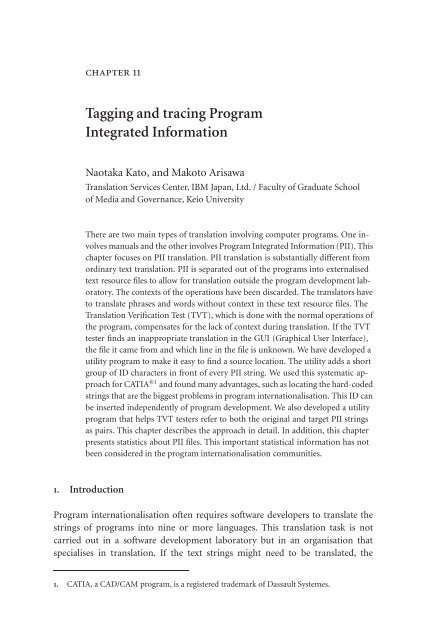Topics in Language Resources for Translation ... - ymerleksi - home
Topics in Language Resources for Translation ... - ymerleksi - home
Topics in Language Resources for Translation ... - ymerleksi - home
- No tags were found...
You also want an ePaper? Increase the reach of your titles
YUMPU automatically turns print PDFs into web optimized ePapers that Google loves.
chapter 11Tagg<strong>in</strong>g and trac<strong>in</strong>g ProgramIntegrated In<strong>for</strong>mationNaotaka Kato, and Makoto Arisawa<strong>Translation</strong> Services Center, IBM Japan, Ltd. / Faculty of Graduate Schoolof Media and Governance, Keio UniversityThere are two ma<strong>in</strong> types of translation <strong>in</strong>volv<strong>in</strong>g computer programs. One <strong>in</strong>volvesmanuals and the other <strong>in</strong>volves Program Integrated In<strong>for</strong>mation (PII). Thischapter focuses on PII translation. PII translation is substantially different fromord<strong>in</strong>ary text translation. PII is separated out of the programs <strong>in</strong>to externalisedtext resource files to allow <strong>for</strong> translation outside the program development laboratory.The contexts of the operations have been discarded. The translators haveto translate phrases and words without context <strong>in</strong> these text resource files. The<strong>Translation</strong> Verification Test (TVT), which is done with the normal operations ofthe program, compensates <strong>for</strong> the lack of context dur<strong>in</strong>g translation. If the TVTtester f<strong>in</strong>ds an <strong>in</strong>appropriate translation <strong>in</strong> the GUI (Graphical User Interface),the file it came from and which l<strong>in</strong>e <strong>in</strong> the file is unknown. We have developed autility program to make it easy to f<strong>in</strong>d a source location. The utility adds a shortgroup of ID characters <strong>in</strong> front of every PII str<strong>in</strong>g. We used this systematic approach<strong>for</strong> CATIA ®1 and found many advantages, such as locat<strong>in</strong>g the hard-codedstr<strong>in</strong>gs that are the biggest problems <strong>in</strong> program <strong>in</strong>ternationalisation. This ID canbe <strong>in</strong>serted <strong>in</strong>dependently of program development. We also developed a utilityprogram that helps TVT testers refer to both the orig<strong>in</strong>al and target PII str<strong>in</strong>gsas pairs. This chapter describes the approach <strong>in</strong> detail. In addition, this chapterpresents statistics about PII files. This important statistical <strong>in</strong><strong>for</strong>mation has notbeen considered <strong>in</strong> the program <strong>in</strong>ternationalisation communities.1. IntroductionProgram <strong>in</strong>ternationalisation often requires software developers to translate thestr<strong>in</strong>gs of programs <strong>in</strong>to n<strong>in</strong>e or more languages. This translation task is notcarried out <strong>in</strong> a software development laboratory but <strong>in</strong> an organisation thatspecialises <strong>in</strong> translation. If the text str<strong>in</strong>gs might need to be translated, the1. CATIA, a CAD/CAM program, is a registered trademark of Dassault Systemes.
















